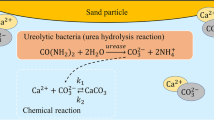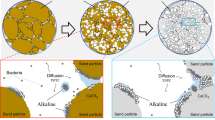Abstract
Microbial carbonate precipitation is expected to play a major role in next-generation soil improvement technologies. To date, research into this method has relied on experimental and/or observational approaches. However, in order to understand the long-term effects of microbial carbonate precipitation and apply these to real environments, it is necessary to employ a predictive approach to determine the future state of the soil when using this soil improvement method. In this work, a mathematical model and numerical simulations based on the reaction–diffusion system for the microbial urea hydrolysis reaction are proposed. These techniques may be used to provide the spatiotemporal precipitation patterns of carbonates between soil particles and the particle surfaces. The simulation results revealed that the characteristic precipitation patterns depend on the diffusion of carbonates caused by the microbial urea hydrolysis reaction, and there was a significant shift in the amount of carbonate from a dissipated state into an equilibrium state.








Similar content being viewed by others
References
Akiyama M, Kawasaki S (2019) Biogeochemical simulation of microbially induced calcite precipitation with Pararhodobacter sp. strain SO1. Acta Geotech 14(3):685–696
Al-Thawadi S, Cord-Ruwisch R (2012) Calcium carbonate crystals formation by ureolytic bacteria isolated from Australian soil and sludge. J Adv Sci Eng Res 2(1):12–26
Alvarez R, Steinbach HS (2009) A review of the effects of tillage systems on some soil physical properties, water content, nitrate availability and crops yield in the Argentine Pampas. Soil Tillage Res 104(2009):1–15
Ben-Jacob E, Cohen I, Shochet O, Aranson I, Levine H, Tsimring L (1995) Complex bacterial patterns. Nature 373(6515):566
Boore DM (2003) Simulation of ground motion using the stochastic method. Pure appl Geophys 160(2003):635–676
Boquet E, Boronat A, Ramos-Cormenzana A (1973) Production of calcite (calcium carbonate) crystals by soil bacteria is a general phenomenon. Nature 246(5434):527
Cambell CS, Cleary PW, Hopkins M (1995) Large-scale landslide simulations: global deformation, velocities and basal friction. J Geophys Res 100(B5):8267–8283
Chen W, Qie T (2011) Numerical simulations for large deformation of granular materials using smoothed particle hydrodynamics method. Int J Geomech 12(2):127–135
Cheng L, Shahin MA, Chu J (2019) Soil bio-cementation using a new one-phase low-pH injection method. Acta Geotech 14(3):615–626
Chou CW, Seagren EA, Aydilek AH, Lai M (2011) Biocalcification of sand through ureolysis. J Geotech Geoenviron Eng 137(12):1179–1189
Chu J, Ivanov V, Naeimi M, Stabnikov V, Liu HL (2014) Optimization of calcium-based bioclogging and biocementation of sand. Acta Geotech 9(2):277–285
Cil MB, Alshibli KA (2014) 3D analysis of kinematic behavior of granular materials in triaxial testing using DEM with flexible membrane boundary. Acta Geotech 9(2):287–298
Cohen I, Golding I, Kozlovsky Y, Ben-Jacob E, Ron IG (1999) Continuous and discrete models of cooperation in complex bacterial colonies. Fractals 7(03):235–247
Dadda A, Geindreau C, Emeriault F, du Roscoat SR, Garandet A, Sapin L, Filet AE (2017) Characterization of microstructural and physical properties changes in biocemented sand using 3D X-ray microtomography. Acta Geotech 12(5):955–970
Danjo T, Kawasaki S (2016) Microbially induced sand cementation method using Pararhodobacter sp. strain SO1, inspired by beachrock formation mechanism. Mater Trans 57(3):428–437
De Muynck W, De Belie N, Verstraete W (2010) Microbial carbonate precipitation in construction materials: a review. Ecol Eng 36(2):118–136
DeJong JT, Fritzges MB, Nüsslein K (2006) Microbially induced cementation to control sand response to undrained shear. J Geotech Geoenviron Eng 132(11):1381–1392
DeJong JT, Mortensen BM, Martinez BC, Nelson DC (2010) Bio-mediated soil improvement. Ecol Eng 36(2010):197–210
Desrues J, Chambon R, Mokni M, Mazerolle F (1996) Void ratio evolution inside shear bands in triaxial sand specimens studied by computed tomography. Géotechnique 46(3):529–546
Ek MB, Mitchell KE, Lin Y, Rogers E, Grunmann P, Koren V, Gayno G, Tarpley JD (2003) Implementation of Noah land surface model advances in the national centers for environmental prediction operational mesoscale Eta model. J Geophys Res 108(D22):8851
Fauriel S, Laloui L (2012) A bio-chemo-hydro-mechanical model for microbially induced calcite precipitation in soils. Comput Geotech 46(2012):104–120
Feng K, Montoya BM, Evans TM (2017) Discrete element method simulations of bio-cemented sands. Comput Geotech 85(2017):139–150
Gao Y, Hang L, He J, Chu J (2019) Mechanical behaviour of biocemented sands at various treatment levels and relative densities. Acta Geotech 14(3):697–707
Golding I, Kozlovsky Y, Cohen I, Ben-Jacob E (1998) Studies of bacterial branching growth using reaction–diffusion models for colonial development. Phys A 260(3–4):510–554
Hatanaka M, Feng L, Matsumura N, Yasu H (2008) A study on the engineering properties of sand improved by the sand compaction pile method. Soils Found 48(1):73–85
Hirose K, Matsubara H (2018) Mechanisms of mudcrack formation and growth in bentonite paste. J Geotech Geoenviron Eng 144(4):04018017
Horpibulsuk S, Miura N, Nagaraj TS (2005) Clay-water/cement ratio identity for cement admixed soft clays. J Geotech Geoenviron Eng 131(2):187–192
Hungr O (1995) A model for the runout analysis of rapid flow slides, debris flows, and avalanches. Can Geotech J 32(4):610–623
Iwashita K, Oda M (2000) Micro-deformation mechanism of shear banding process based on modified distinct element method. Powder Technol 109(2000):192–205
Kondo S, Miura T (2010) Reaction–diffusion model as a framework for understanding biological pattern formation. Science 329(5999):1616–1620
Konhauser KO (2007) Introduction to geomicrobiology. Wiley, Hoboken
Kozlovsky Y, Cohen I, Golding I, Ben-Jacob E (1999) Lubricating bacteria model for branching growth of bacterial colonies. Phys Rev E 59(6):7025
Lee KJ, McCormick WD, Pearson JE, Swinney HL (1994) Experimental observation of self-replicating spots in a reaction–diffusion system. Nature 369(6477):215
Matsushita M, Hiramatsu F, Kobayashi N, Ozawa T, Yamazaki Y, Matsuyama T (2004) Colony formation in bacteria: experiments and modeling. Biofilms 1(4):305–317
Matsushita M, Wakita J, Itoh H, Watanabe K, Arai T, Matsuyama T, Sakaguchi H, Mimura M (1999) Formation of colony patterns by a bacterial cell population. Phys A 274(1–2):190–199
McCutcheon J, Nothdurft DL, Webb EG, Shuster J, Nothdurft L, Paterson D, Southam G (2017) Building biogenic beachrock: visualizing microbially-mediated carbonate cement precipitation using XFM and a strontium tracer. Chem Geol 465:21–34
Mortensen BM, Haber MJ, DeJong JT, Caslake LF, Nelson DC (2011) Effects of environmental factors on microbial induced calcium carbonate precipitation. J Appl Microbiol 111(2):338–349
Okwadha GD, Li J (2010) Optimum conditions for microbial carbonate precipitation. Chemosphere 81(9):1143–1148
Oshiro H, Matsubara H (2018) Carbonate precipitation through photoautotrophic microorganisms at the Giza cliff in Okinawa, Japan. Environ Earth Sci 77:591
Pearson JE (1993) Complex patterns in a simple system. Science 261(5118):189–192
Rosen BP (1987) Bacterial calcium transport. Biochim Biophys Acta Rev Biomembr 906(1):101–110
Sakiyama H, Matsubara H (2018) Physical, chemical, and biological investigation of an unconformity between limestone and sandstone in a coastal area: Iriomote Island case study. CATENA 171(2018):136–144
Sánchez-Román M, Rivadeneyra MA, Vasconcelos C, McKenzie JA (2007) Biomineralization of carbonate and phosphate by moderately halophilic bacteria. FEMS Microbiol Ecol 61(2):273–284
Shen S, Chai J, Hong Z, Cai F (2005) Analysis of field performance of embankments on soft clay deposit with and without PVD-improvement. Geotext Geomembr 23(2005):463–485
Sun X, Miao L, Tong T, Wang C (2019) Study of the effect of temperature on microbially induced carbonate precipitation. Acta Geotech 14(3):627–638
Tagliaferri F, Waller J, Andò E, Hall SA, Viggiani G, Bésuelle P, DeJong JT (2011) Observing strain localisation processes in bio-cemented sand using x-ray imaging. Granul Matter 13(3):247–250
Terzis D, Laloui L (2018) 3-D micro-architecture and mechanical response of soil cemented via microbial-induced calcite precipitation. Sci Rep 8(1):1416
Terzis D, Laloui L (2019) Cell-free soil bio-cementation with strength, dilatancy and fabric characterization. Acta Geotech 14(3):639–656
Thompson JB, Ferris FG (1990) Cyanobacterial precipitation of gypsum, calcite, and magnesite from natural alkaline lake water. Geology 18(10):995–998
Turing AM (1952) The chemical basis of morphogenesis. Philos Trans R Soc Lond B Biol Sci 237(641):37–72
Whiffin VS, Paassen LA, Harkes MP (2007) Microbial carbonate precipitation as a soil improvement technique. Geomicrobiol J 24(2):417–423
White AF, Bullen TD, Vivit DV, Schulz MS, Clow DW (1999) The role of disseminated calcite in the chemical weathering of granitoid rocks. Geochim Cosmochim Acta 63(13–14):1939–1953
Więckowski Z (2004) The material point method in large strain engineering problems. Comput Methods Appl Mech Eng 193(39–41):4417–4438
Wu Y, Ajo-Franklin JB, Spycher N, Hubbard SS, Zhang G, Williams KH, Taylor J, Fujita Y, Smith R (2011) Geophysical monitoring and reactive transport modeling of ureolytically-driven calcium carbonate precipitation. Geochem Trans 12(1):7
Zhu T, Dittrich M (2016) Carbonate precipitation through microbial activities in natural environment, and their potential in biotechnology: a review. Front Bioeng Biotechnol 4:4
Acknowledgements
The authors acknowledge the helpful comments and discussions by Prof. Aydan Ömer, Prof. Eizo Nakaza, Dr. Kosaburo Hirose, and Mr. Ryogo Kawakami, University of the Ryukyus. This work was supported by the JSPS Grant-in-Aid for Young Scientists (B) Grant Number 26790079 and by the University of the Ryukyus Strategic Research Grant.
Author information
Authors and Affiliations
Corresponding author
Additional information
Publisher's Note
Springer Nature remains neutral with regard to jurisdictional claims in published maps and institutional affiliations.
Electronic supplementary material
Below is the link to the electronic supplementary material.
Rights and permissions
About this article
Cite this article
Matsubara, H., Yamada, T. Mathematical modelling and simulation of microbial carbonate precipitation: the urea hydrolysis reaction. Acta Geotech. 15, 29–38 (2020). https://doi.org/10.1007/s11440-019-00896-6
Received:
Accepted:
Published:
Issue Date:
DOI: https://doi.org/10.1007/s11440-019-00896-6




